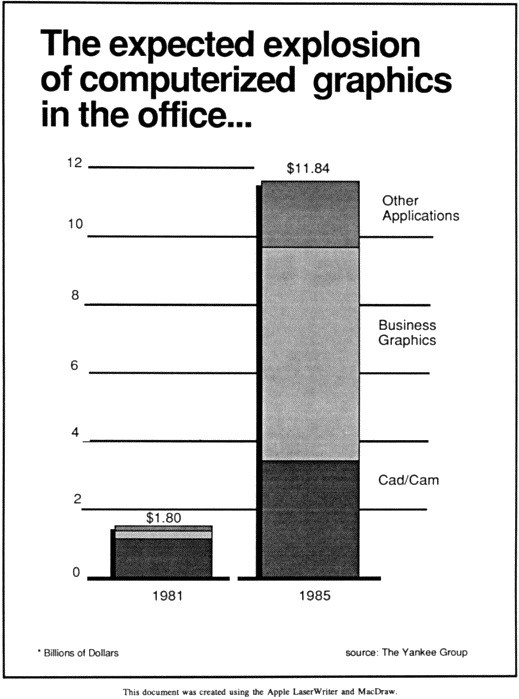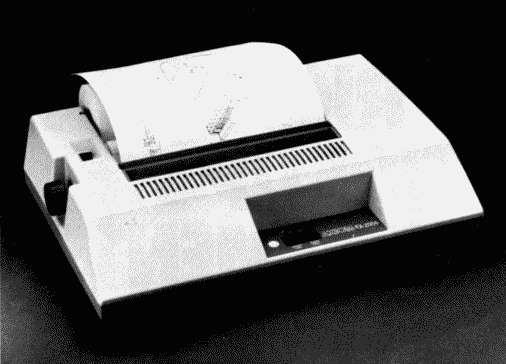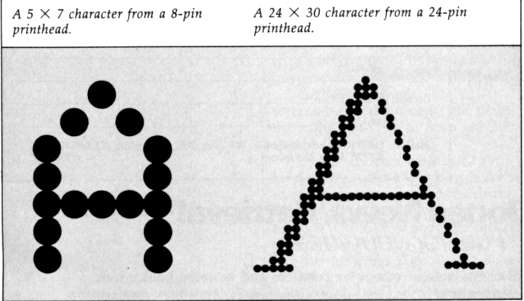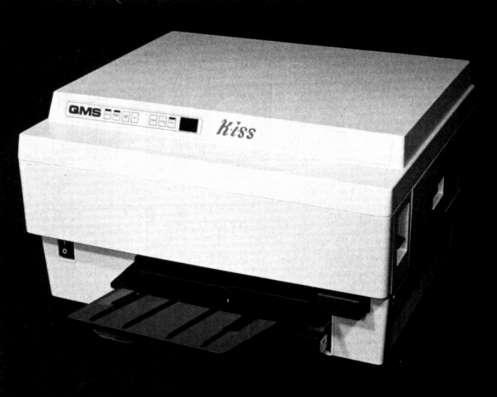The Changing Face Of Printer Technology
Joan Rouleau, Research/Copy Editor
Joan Rouleau, Research/Copy Editor
Today's printers are better than ever: They're faster, quieter, more versatile, less expensive, and produce higher-quality output than even their recent predecessors. Innovative new technologies-such as lasers and LED arrays-are offering more choices for home computer owners, while the more established technologies-such as dot-matrix, daisywheel, and ink-jet printers-have been greatly refined. Here's a look at some of the changes that are reshaping the printer marketplace.
Just five years ago, a 40-characters-per-second daisywheel printer was advertised in this magazine for almost $2,000-and that was a discount price. Today, that same cash can buy a silent, six-page-per-minute, multiple-font laser printer. Similarly, it wasn't very long ago that the blocky, awkward type produced by dot-matrix printers was appropriate only for printing draft copy. Now, with print resolution as great as 300 dots per inch in some new models, dot-matrix printers are reaching true letter quality. Better yet, the intense competition among manufacturers and retailers continues to push prices down and spawn a wider selection of features.
Printers are becoming such an integral part of the home computerist's workroom that only in a tech nical sense can they still be considered peripherals. The percentage of home computer owners with a printer nearly doubled between 1983 and 1985: from 28 percent to 53 percent, according to Link Resources, a New York market research firm. This trend is tied to an increase in word processing and business applications in the home, says the Link study.
Not only are more people buying printers, but they're also expecting more from the printers they buy. In particular, more and more people want better-quality print. A recent survey by another market research firm, Frost & Sullivan of New York, named print clarity as the single most important factor among those choosing a letter-quality printer. Other factors were ease of repair, long life, and then price.
Answering this demand for better print is a wide array of new nonimpact printers and substantial improvements in dot-matrix printers. Laser printers, once affordable only by large businesses, have just begun to drop in price. Within a couple of years, they, too, may become a contender in the home printer arena.

A sample of near-typeset quality output from a laser printer.
Laser printers were originally developed about a decade ago for use with mainframe computers, and they work much like photocopy machines. In a photocopier, the original is illuminated with a bright light that transfers the image of the page onto a light-sensitive drum. Through a thermal and electrochemical process, the drum then fuses the image onto another sheet of paper.
A laser printer works in a similar way, but uses a low-power laser to scribe the images onto the drum. Therefore, it is a page printer-it prints a whole page at a time rather than a single character at a time, like most printers. The newest laser printers can print up to a fleeting 12 pages per minute. And unlike most dot-matrix or daisywheel printers, they run quietly.
In the last couple of years, improvements in laser and photocopy technology brought the price of laser printers down to the $7,000 range, making them accessible to considerably more businesses. Then, last fall, QMS of Mobile, Alabama, introduced its Kiss laser printer for only $1,995, bringing this technology within reach of small businesses and some home users.
Among the other manufacturers who are developing laser printers in the $2,000 to $3,000 range are Okidata, Canon, Mannesmann Tally, Dataproducts, and ITT Qume. Many industry watchers predict that a $1,000 laser printer will be available by the end of 1987.
Others, however, are more skeptical about how soon the laser printer will become a mainstay in the home. Laser printers are still quite costly to manufacture, they argue, and it may be some time before these costs go down. Virtually all of the mechanisms for laser printers are made in Japan, and the devaluation of the dollar against the yen may keep laser printers more expensive for a while.
Perhaps in light of these considerations, some manufacturers are looking to other nonimpact technologies for their page printers. Particularly favored among several manufacturers is the light-emitting diode (LED) array. LEDs are tiny semiconductors that emit light when energized by a pulse of current, often seen as power indicator lights on stereos and computers. LED printers work something like laser printers, except they use an LED array to print the page instead of a laser. LED array printers are comparable in speed to laser printers, and because they have fewer moving parts, they are cheaper to produce and transport. Among the manufacturers who have chosen LED technology for their page printers are IBM and Datasouth.
Another nonimpact technology, ion deposition, also is making its debut. Instead of using light to transfer the image onto a drum, these printers shoot ion beams onto an electrically conductive drum.

Axiom's TX 2000 can print out a hardcopy of any video display.
Unlike laser or LED printers, ion deposition printers do not use heat as part of the transfer process. Companies investigating this technology include Star Micronics, Mannesmann Tally, and C. Itoh. Mannesmann's director of marketing, John Roberts, predicts that ion deposition printers are "the nonimpact technology that will probably come closest to replacing impact printers."
On another front, ink-jet printers continue to evolve and generate interest. These printers, as the name implies, spray a jet of ink from several tiny nozzles onto the paper. When first introduced, they could only produce draft-quality copy which had a tendency to smudge. Now major manufacturers such as Canon and Diablo are perfecting this technology and are reportedly developing high-resolution ink-jet printers.
Nonimpact technology is still in its infancy and will likely undergo a great many changes-in speed, price, and sophistication-over the next few years. "Lasers have opened the door. We're finding that there are other doors," says Tom Bongiorno, director of marketing for Star Micronics. "Just as when the first dot-matrix printer came out, it was certainly a breakthrough. Then print quality became better, prices dropped to one third or less than initially ... the quality continues to pick up and prices will probably still drop."

Does this surge of new nonimpact printers aimed at the home market mean the demise of dot-matrix? Not anytime soon. Dot-matrix printers are still considerably cheaper and have improved quite a lot over the past couple of years. Says Dennis Cox of Epson America, "There's continued optimism and growth in the dotmatrix industry. We're seeing more products become available, improved features, and new price levels."
Just in the last year, the resolution of dot-matrix print has greatly improved. All dot-matrix printers use a printhead which consists of a vertical row of stacked wires. As the printhead moves across the page, these wires are hammered onto the paper in different patterns to form characters in a rectangular matrix. When dot-matrix printers were first introduced, characters were formed in a 5 X 7 or 8 X 8 matrix (see the accompanying figure). Now several printers are on the market which have 18 or even 24 wires in their printheads. This allows the printer to form characters which are much better defined, and produce better graphics as well. Improvements have also been made which enable better positioning of the printhead, so even nine-wire printheads can produce higher-quality print than ever before.
Among the new high-resolution dot-matrix printers are Toshiba's P321 ($699), which features a 24 wire printhead, 80-column carriage, and multiple type font cartridges. Okidata's 2410 ($2,395) also has a 24-wire printhead and can print 136 columns across. Star Micronic's NB-15 ($1,449), another 24-wire printer, produces letter quality at 100 characters per second (cps) and draft quality at 300 cps, and has a 16K buffer. NEC has a new line of dot-matrix printers which includes the 24-wire Pinwriter P5 ($1440-$1560). Fujitsu America's 24-wire dot-matrix printer has a liquid crystal display which shows the print status. Recently released 18-wire dot matrix printers include Mannesmann Tally',s MT490 and Datasouth's DS440 (prices haven't been released for either machine). While these may still be a little too expensive for many home users, the prognosis for less costly high-resolution dotmatrix printers over the next few years is very good.
Dot-matrix printers are also improving in speed and other features. "What we feel is the trend for the dot-matrix market right now is that more and more features are being built into printers," says Frank Rexach, product manager for C. Itoh. Some of the features in C. Itoh's new C310 are 300 cps draft printing, paper feeding from the top, bottom, and rear, and all control keys located on the front panel.
The dot-matrix printer's chief rival, the daisywheel, stands a chance of being superseded by the letter-quality dot-matrix printers and the new nonimpact devices. Daisywheel printers work much like typewriters and used to be the only way to get letter-quality print. Now many manufacturers have slowed or stopped their production of daisywheels while expanding into the dot-matrix and nonimpact areas.
As Mannesmann Tally's John Roberts says, "Daisywheel manufacturers are the most subject to displacement by the laser printer." Or, as another manufacturer puts it, "I wouldn't want to be only in the daisywheel market right now."

The first laser printer for under $2,000: The new Kiss from QMS.
Anyone who s ever tried to use a printer for graphics knows how difficult it can be. While virtually all dot-matrix printers have some graphics capability, there are no standard control codes for accessing this feature. Programs that print graphics have a hard time supporting all the different printers that are available.
This situation has led to the development of page description languages. With a page description language, your software can access features like graphics and text in several fonts without knowing what kind of printer you have. All that's necessary is that your printer understand the page description language that your software is generating. One of the most popular of these is PostScript by Adobe Systems, which can be used with the Apple LaserWriter and other printers.
Thanks to PostScript, highquality printing is available to those who can't justify the expense of a laser printer for occasional printing jobs. A document description can be sent over a phone line with a modem, and some professional typesetting machines understand PostScript. So in some areas, it's already possible to create and lay out a document, upload it to a print shop that has one of these typesetters, and have it typeset without leaving your home.
Other new developments in the area of printer graphics include the digital videoprinter-a printer which makes hardcopy from any type of raster-scan video display (including computer monitors and TVs). The TX 2000 videoprinter, recently released by Axiom Corporation, can capture a moving video image and even rotate or reverse the image. The TX 2000 lists for $1,995.
A number of new color printers are also opening up new graphics possibilities for home computers. Juki has just released a nine-wire color dot-matrix printer which can produce up to seven colors from a four-color ribbon. Fujitsu America is offering a color version of its 24wire dot-matrix printer. And a few companies are developing color laser printers for use with personal computers. It'll be a while before these devices are found in many homes, though-color laser printers, like color photocopiers, are still very expensive.
Advances in printer technology continue at a rapid pace, and the printers that have been recently announced demonstrate just how quickly the market is progressing. Whether you need a simple and inexpensive dot-matrix printer for casual use or a state-of-the-art laser printer for near-typeset quality documents, the latest printers provide unprecedented performance at far lower prices.